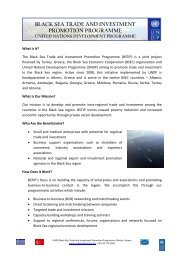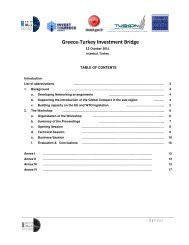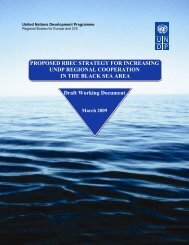Tradeflow Study - UNDP Black Sea Trade and Investment Promotion ...
Tradeflow Study - UNDP Black Sea Trade and Investment Promotion ...
Tradeflow Study - UNDP Black Sea Trade and Investment Promotion ...
You also want an ePaper? Increase the reach of your titles
YUMPU automatically turns print PDFs into web optimized ePapers that Google loves.
Table 1 presents some interesting indicators related to private sector, trade <strong>and</strong> infrastructure<br />
development. The share of the private sector in the national economy varies from 55 percent<br />
in the case of Serbia to 75 percent in the cases of Albania <strong>and</strong> Armenia. The private sector<br />
accounts for the largest share of employment, though in general this corresponds<br />
approximately to the ratio of the private sector in GDP.<br />
Table 1. Basic structural indicators of transition BSEC economies, 2005<br />
Albania Armenia Azerbaijan Bulgaria Georgia Moldova Romania Russia Serbia Ukraine<br />
Macroeconomic<br />
Private sector share in GDP (%) 75.0 75.0 60.0 75.0 65.0 60.0 70.0 65.0 55.0 65.0<br />
Private sector share in employment (%) 80.0 na 68.1 71.0 77.7 60.0 na na na na<br />
<strong>Investment</strong>/GDP (%) 26.6 23.2 56.1 28.0 26.3 29.8 22.7 20.9 na 22.2<br />
International <strong>Trade</strong><br />
Share of trade with non-transition countries (%) 87.4 69.2 65.7 75.0 57.2 37.7 77.3 73.2 na 48.6<br />
Finance<br />
Non-performing loans (in per cent of total loans) 2.3 2.1 14.9 3.8 3.8 5.3 6.1 2.8 23.8 19.0<br />
Domestic credit to private sector (% of GDP) 10.3 8.0 6.2 26.0 14.8 25.4 10.2 25.7 na 35.2<br />
Telecommunications<br />
Fixed-line (mobile) penetration rate (per 100 inhabitants) 8.6 (39.5) 19.3 (10.6) 13.0 (26.7) 32.1 (80.8) 15.1 (32.6) 22.1 (25.9) 20.2 (61.5) 27.9 (83.6) 32.9 (64.0) 25.8 (37.0)<br />
Internet penetration rate (per 10,000 inhabitants) 1.7 6.3 0.4 84.7 14.0 31.2 22.6 59.4 33.8 27.7<br />
Source : EBRD Transition Report 2006<br />
The financial sector reforms in a number of BSEC countries have created a more enabling<br />
environment for business, in particular for bridging inter-temporal consumption-investment<br />
constraints. However, the share of non-performing loans remains significant for a number of<br />
economies in the region <strong>and</strong> is of concern to the stability of the financial sector.<br />
Figure 2 presents the inflows <strong>and</strong> outflows of FDI in BSEC countries. Outflows signify more<br />
often than not, disinvestment in the country as opposed to new investment abroad. Azerbaijan<br />
is by far the largest recipient of FDI as a proportion of GDP in the region, which is entirely<br />
absorbed by the energy sector. Other countries enjoy far smaller levels of FDI though these<br />
tend to be more evenly distributed across sectors of the economy. The larger economies<br />
tend to be far smaller recipients of FDI, in part because the national contribution to gross fixed<br />
capital formation is large <strong>and</strong> in part because BSEC’s ability to attract FDI outside of the<br />
energy sector is relatively limited.<br />
Gross Fixed Capital Formation (GFCF) ranges from 17 percent in Serbia <strong>and</strong> Montenegro to<br />
30 percent in Armenia. GFCF is exceptionally high in Azerbaijan owing to Azerbaijan’s<br />
singularity with exceptionally high FDI in the energy sector. In absolute terms, Russia’s<br />
domestic investment dwarfs other members of BSEC, since it accounts for half of all BSEC’s<br />
GFCF.<br />
15/135






